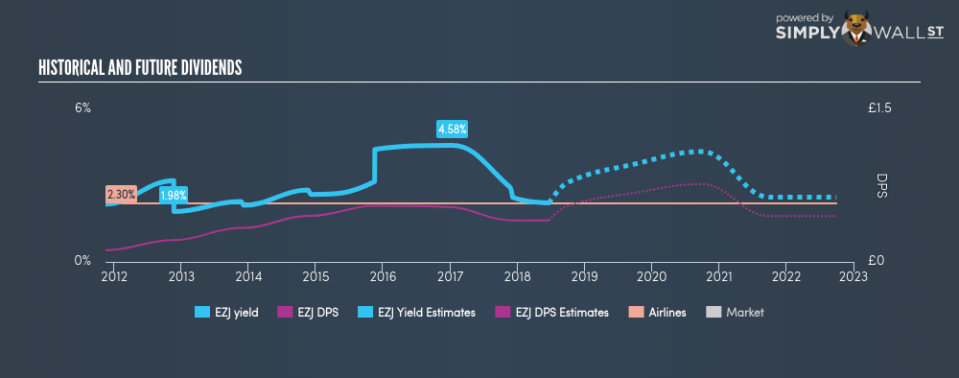Does easyJet plc (LON:EZJ) Have A Place In Your Portfolio?

A large part of investment returns can be generated by dividend-paying stock given their role in compounding returns over time. In the past 7 years easyJet plc (LON:EZJ) has returned an average of 3.00% per year to investors in the form of dividend payouts. Let’s dig deeper into whether easyJet should have a place in your portfolio. View out our latest analysis for easyJet
5 questions to ask before buying a dividend stock
When researching a dividend stock, I always follow the following screening criteria:
Is its annual yield among the top 25% of dividend-paying companies?
Has its dividend been stable over the past (i.e. no missed payments or significant payout cuts)?
Has dividend per share risen in the past couple of years?
Can it afford to pay the current rate of dividends from its earnings?
Based on future earnings growth, will it be able to continue to payout dividend at the current rate?
How does easyJet fare?
The current trailing twelve-month payout ratio for the stock is 36.42%, which means that the dividend is covered by earnings. In the near future, analysts are predicting a higher payout ratio of 55.04%, leading to a dividend yield of 3.71%. In addition to this, EPS should increase to £1.17. The higher payout forecasted, along with higher earnings, should lead to greater dividend income for investors moving forward.
If there is one thing that you want to be reliable in your life, it’s dividend stocks and their constant income stream. The reality is that it is too early to consider easyJet as a dividend investment. It has only been consistently paying dividends for 7 years, however, standard practice for reliable payers is to look for a 10-year minimum track record.
Relative to peers, easyJet produces a yield of 2.32%, which is high for Airlines stocks but still below the market’s top dividend payers.
Next Steps:
Whilst there are few things you may like about easyJet from a dividend stock perspective, the truth is that overall it probably is not the best choice for a dividend investor. However, if you are not strictly just a dividend investor, the stock could still offer some interesting investment opportunities. Given that this is purely a dividend analysis, you should always research extensively before deciding whether or not a stock is an appropriate investment for you. I always recommend analysing the company’s fundamentals and underlying business before making an investment decision. There are three pertinent factors you should look at:
Future Outlook: What are well-informed industry analysts predicting for EZJ’s future growth? Take a look at our free research report of analyst consensus for EZJ’s outlook.
Historical Performance: What has EZJ’s returns been like over the past? Go into more detail in the past track record analysis and take a look at the free visual representations of our analysis for more clarity.
Dividend Rockstars: Are there better dividend payers with stronger fundamentals out there? Check out our free list of these great stocks here.
To help readers see pass the short term volatility of the financial market, we aim to bring you a long-term focused research analysis purely driven by fundamental data. Note that our analysis does not factor in the latest price sensitive company announcements.
The author is an independent contributor and at the time of publication had no position in the stocks mentioned.

 Yahoo Finance
Yahoo Finance 
